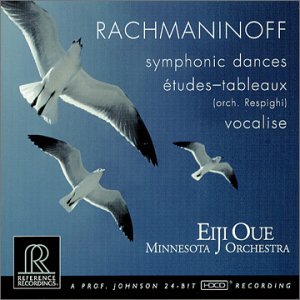Of the three pieces, the Symphonic Dances shows
that Rachmaninov, in his last work, is still developing his skill in
the handling of instrumental colour. The results are masterly. Vocalise,
a relatively early work (at seven minutes or less forever doomed to
be CD filler fodder) illustrates how far he had travelled, the thick
romantic textures contrasting with the confident airiness of the Symphonic
Dances. Finally, in the five Etudes-Tableaux we have the
chance to hear how another composer skilled in the art of orchestration
has set about realising some tricky piano pieces that Rachmaninov wrote
around the time of Vocalise.
The meat of this disc is in the Symphonic Dances,
a work that started off as potential ballet music but, once Rachmaninov
got his teeth into the composition, evolved into a three-movement concert
piece of symphonic proportions. It has been recorded many times as one
would expect for a natural orchestral showpiece. The trap into which
some conductors fall is to treat the work as such - a showpiece. Overindulgence
can be the enemy of this work in performance, often at the expense of
rhythmic drive and the subtleties of some of the melodic development
and transformation which justify the use of "symphonic" in the title.
Oue, with the excellent Minnesota Orchestra, avoids the most damaging
temptations, maintaining the vitality of the dance aspect, ensuring
the cohesion of each movement and at the same time maintaining opulence
of sound without hint of romantic slush. The first movement builds well,
Oue pointing to the development of the melodic fragments that give the
music a natural sense of evolution culminating in the inevitable big
tune at the end of the first section. The waltz rhythms of the second
movement are one of the means by which Rachmaninov achieves unity in
music of great mood and textural contrast and Oue understands this well.
More than the other two, the last movement is the one where the showpiece
characteristics of the music can lead conductors and orchestras astray
but the Minnesota players handle everything Rachmaninov throws at them
with confidence, and after the blazing close of the work we can believe,
thanks to Oue, that we have heard music that really is "symphonic"
and not just a ballet score wheeled out for concert performance.
Conversely, the five Etudes-Tableaux
orchestrations were suggested by Koussevitsky as concert pieces
where they might just as well have served as a ballet. They do not have
the constructional qualities of the Symphonic Dances nor seem
to follow the titles closely as far as picture painting is concerned
(the original piano pieces had no titles). Rarely recorded, this disc
is welcome in providing a chance to hear them played with such commitment,
making the most of Respighi’s instrumentation skills. However, one is
forced to make comparisons with the Symphonic Dances and to wish
that if the job of orchestration had to be done, Rachmaninov had done
it himself. Respighi is faithful to the musical text and he is clearly
trying to make the pieces sound like Rachmaninov but his rendering,
although superbly skilful in a text book sort of way, lacks the inventiveness
Rachmaninov would have brought to it. There are many recordings of the
two original sets of piano pieces (or selections from them – including
Rachmaninov himself in a piano roll version) and maybe that is how they
are best heard.
What makes this disc really worth listening to is the
sound. Either the engineers have been extremely clever or the acoustic
is exceptional (perhaps both). I have not had the privilege of attending
a concert in the Orchestra Hall, Minneapolis, but if this recording
is anything to go by it has the acoustical qualities of the finest venues.
The best I do know is the Walthamstow Assembly Hall in North East London
where, in seeming contradiction, a warm ambience combines with a clarity
and balance that exposes any fudging that may go on in inner parts.
The Minnesota Orchestra meets the challenge of a similar acoustic. The
sturdy intonation and clean-limbed sound of the strings thrive in their
own environment and are a refreshing joy to behold – just listen to
the big tune in the Symphonic Dances’ first movement.
If you want a lot of idiomatic Russian punch in the
Symphonic Dances as opposed to Oue’s French – type sophistication
and control, then you may prefer Mariss Jansons much admired
1993 performance with the St Petersburg Philharmonic. You also get Rachmaninov’s
Third Symphony which makes for a heftier offering and, for some,
better value. But if you want superb sound with playing to match and
the novelty of a Rachmaninov/Respighi collaboration, then this disc
is a genuine competitor.
John Leeman

![]() Minnesota
Orchestra/Eiji Oue
Minnesota
Orchestra/Eiji Oue ![]() REFERENCE
RECORDINGS RR-96 HDCD [67.06]
REFERENCE
RECORDINGS RR-96 HDCD [67.06]